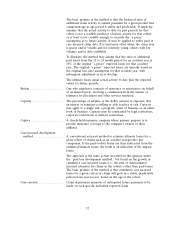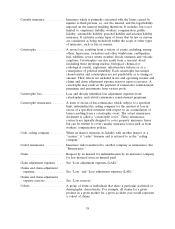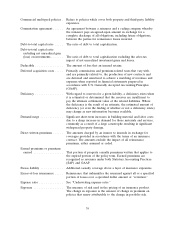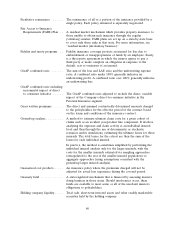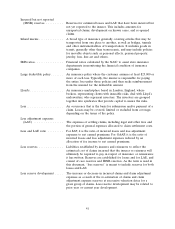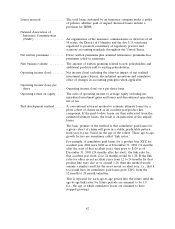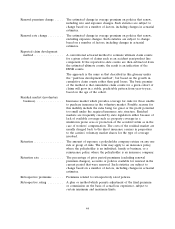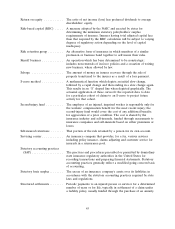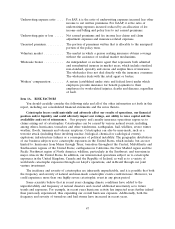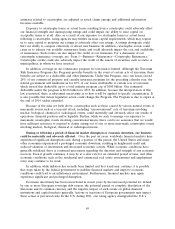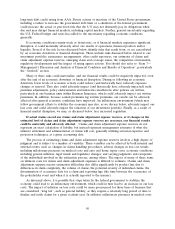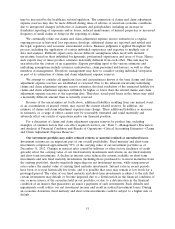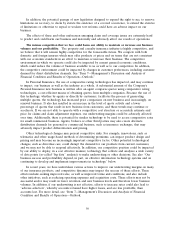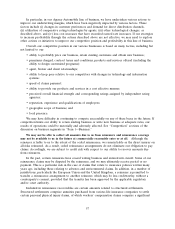Travelers 2012 Annual Report Download - page 59
Download and view the complete annual report
Please find page 59 of the 2012 Travelers annual report below. You can navigate through the pages in the report by either clicking on the pages listed below, or by using the keyword search tool below to find specific information within the annual report.Underwriting expense ratio .... For SAP, it is the ratio of underwriting expenses incurred less other
income to net written premiums. For GAAP, it is the ratio of
underwriting expenses incurred reduced by an allocation of fee
income and billing and policy fees to net earned premiums.
Underwriting gain or loss ..... Net earned premiums and fee income less claims and claim
adjustment expenses and insurance-related expenses.
Unearned premium .......... The portion of premiums written that is allocable to the unexpired
portion of the policy term.
Voluntary market ........... The market in which a person seeking insurance obtains coverage
without the assistance of residual market mechanisms.
Wholesale broker ........... An independent or exclusive agent that represents both admitted
and nonadmitted insurers in market areas, which include standard,
non-standard, specialty and excess and surplus lines of insurance.
The wholesaler does not deal directly with the insurance consumer.
The wholesaler deals with the retail agent or broker.
Workers’ compensation ....... A system (established under state and federal laws) under which
employers provide insurance for benefit payments to their
employees for work-related injuries, deaths and diseases, regardless
of fault.
Item 1A. RISK FACTORS
You should carefully consider the following risks and all of the other information set forth in this
report, including our consolidated financial statements and the notes thereto.
Catastrophe losses could materially and adversely affect our results of operations, our financial
position and/or liquidity, and could adversely impact our ratings, our ability to raise capital and the
availability and cost of reinsurance. Our property and casualty insurance operations expose us to
claims arising out of catastrophes. Catastrophes can be caused by various natural events, including,
among others, hurricanes, tornadoes and other windstorms, earthquakes, hail, wildfires, severe winter
weather, floods, tsunamis and volcanic eruptions. Catastrophes can also be man-made, such as a
terrorist attack (including those involving nuclear, biological, chemical or radiological events),
explosions, infrastructure failures or a consequence of political instability. The geographic distribution
of our business subjects us to catastrophe exposures in the United States, which include, but are not
limited to: hurricanes from Maine through Texas; tornadoes throughout the Central, Mid-Atlantic and
Southeastern regions of the United States; earthquakes in California, the New Madrid region and the
Pacific Northwest region of North America; wildfires, particularly in the Southwest; and terrorism in
major cities in the United States. In addition, our international operations subject us to catastrophe
exposures in the United Kingdom, Canada and the Republic of Ireland, as well as to a variety of
world-wide catastrophe exposures through our Lloyd’s operations, and in Brazil through our joint
venture investment.
The incidence and severity of catastrophes are inherently unpredictable, and it is possible that both
the frequency and severity of natural and man-made catastrophic events could increase. Moreover, we
could experience more than one highly severe catastrophic event in any given period.
Some scientists believe that in recent years changing climate conditions have added to the
unpredictability and frequency of natural disasters and created additional uncertainty as to future
trends and exposures. For example, in recent years hurricane activity has impacted areas further inland
than previously experienced, thus expanding our overall hurricane exposure. Additionally, both the
frequency and severity of tornadoes and hail storms have increased in recent years.
47


